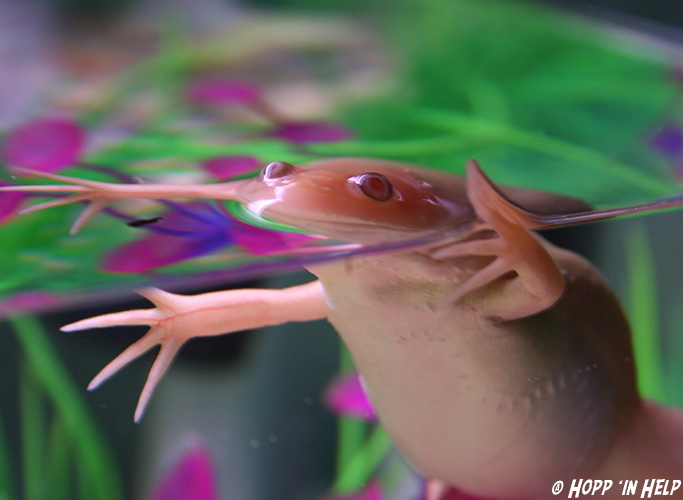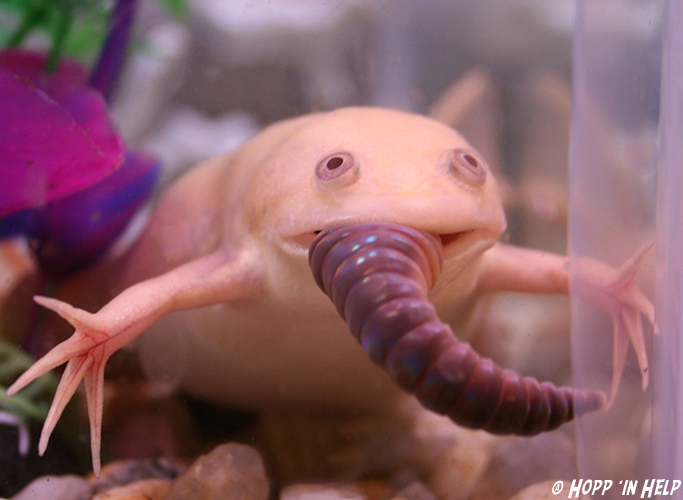AFRICAN CLAWED FROG CARE SHEET
Xenopus laevis

PERSONAL EXPERIENCE: I have had wonderful experiences with African Clawed Frogs. As the only purely freshwater aquatic frogs I have worked with, they are very easy to care for! As someone who may be looking to branch out from fish to frogs, this is a great first step
African Clawed Frogs do require a level of commitment as all amphibians do. They have an instinct to leave poor water quality “pools” by crawling up onto land to find a better home. If you neglect their enclosure, they will escape in search of a suitable body of water. However, your home does not have other pools like their native home of South Africa. Henceforth, this usually does not end well for the frog in a human environment. In short, take proper care of them or they will leave!
A fun fact about these frogs is that they do not have a “traditional” frog tongue, they have no tongue at all! They use their hands to shovel food into their mouths!
CAPTIVITY DIFFICULTY: Intermediate
LIFE SPAN: 15 years
ACTIVITY: African Clawed Frogs are nocturnal, meaning they rest during the day and are active at night. They typically hide away in hides or plants within their enclosure to rest. sleep in the day. At night, they will swim around their tank, call for a mate, and hunt if you feed with live food.
ENCLOSURE: African Clawed Frogs are fully aquatic freshwater frogs. Meaning they require aquariums filled to the proper level needed for your filtration system. An important feature for African Clawed Frogs is a large space to allow them to bolt around their tank. It is key to not use small pebbles for substrate. African Clawed Frogs will consume them and become impacted, usually leading to death. I personally suggest placing a layer of Fluval Plant and Shrimp Stratum. This promotes plant growth and can be passed through the frog if ingested. A variety of live plants will add cover and good nutrients to your enclosure. Java Moss, Java Fern, and Hornwort have flourished in my enclosures with African Clawed Frogs. After placing around 2 inches of stratum on the bottom of the enclosure, you may add a piece of aquarium safe driftwood. I use these wood features as a base to my enclosure, typically going right down the middle. Then plant the tallest plants in the back corners (Of course keep the filter in mind, you do not want the filter sucking up the plants). And then place smaller and smaller plants into the center. This provides open space in the front for them to swim freely. I then placed large pieces of natural slate over the stratum that was exposed. The goal is to cover as much substrate as possible, locking plants roots in, and providing a natural environment. Be sure all stones are secure and will not move with a current. You may add other aquarium decor or driftwood once the base is complete! DIY slate hides make beautiful and natural features in your enclosure as well.
A filtration system is needed for African Clawed frogs unless you pursue a bioactive aquarium. Picking the right filter requires personal research. I have had the best experiences with Tetra’s Whisper line of filters. You will need to find a filter that fits the size of your aquarium (gallons).
If using tap water, water conditioner must be used. This removes harmful chemicals and makes the water safe for your amphibian. Directions vary so be sure to read the label before using.
SIZE OF ENCLOSURE: A single African Clawed Frog requires at least a 10-gallon tank, 20 x 11 x 13 inches, 50.8 x 27.94 x 33.02 cm. However, a single African Clawed Frog or duo will flourish in a 28-gallon tank, ( 30 x 12 x 18 inches, 76.2, 30.5, 45.7cm) or larger.
WATER TEMPERATURE: 65-75 degrees F (18-24 degrees C) A heat source is typically not needed for African Clawed Frogs because they thrive at room temperature. However, keep a thermostat within the tank to ensure proper water temperature.
FEEDING: These frogs will eat anything that fits in their mouth! This can include smaller tank mates. Ensure your frogs are relatively the same size when housed together. I personally suggest adopting the frogs the same day and from the same breeder.

A juvenile African Clawed Frog should have around 4 live crickets, a pinch of blood worms, 3 small earthworms, or a combination every other day. 1-2 Small Comets or Rosies can be fed every 3 days. To feed live crickets, you may use tongs to place them underwater. However, my frogs personally enjoyed swimming up and catching crickets on the surface of the water.
Adult African Clawed Frogs can have a variety of feeds. A mixed diet of Comets, Rosies, feeder Goldfish, earthworms, crickets, and bloodworms help your frog thrive. With larger food like; Comets, Rosies, feeder goldfish, and large earthworms, I would feed 3-4 items twice a week. With smaller food including; Crickets and bloodworms, I would feed 10 crickets or 3 pinches of blood worms every other day. A diverse diet improves your frog’s health. For example: Monday: 3 comets, and one earthworm, Wednesday: 3 pinches of blood worms, Friday: 2 Comets and 3 worms, Sunday: Small snack of bloodworms. My frogs’ favorite are earthworms! I drop them in the tank and allow them to hunt them down. It is a lot of fun watching them gobble them down!
What size fish do I get for my African Clawed Frog? A general rule for feeding Reptiles and Amphibians is, the food in question’s girth should fit in between the animal’s eyes.
HOW TO SEX: Male African Clawed Frogs are usually smaller than females. They have a slim body and legs. They call out or “sing” for a female frog, which sounds like a cricket chirping underwater. They have no cloaca; a bump where the legs meet. When male frogs reach sexual maturity (around 10 months old), they have black nuptial pads on their forearms.
Female African Clawed Frogs have a pear-shaped body with chubby legs. They have a small bump in between their legs (cloaca) where eggs and waste pass. African Clawed Frogs are a species that females respond back to the male’s calls. They make a soft rapping call for acceptance or a slow ticking for rejection of the male.
SIZE: As explained above, African Clawed Frogs vary in size based on sex. An estimated length for an adult African Clawed Frog is 5 inches (12.7cm)
I AM NEW TO FROGS, ARE THEY GOOD FOR BEGINNERS?
These are great frogs for beginners! While they require more care than most freshwater fish, they are a great step from fish to Amphibians!
